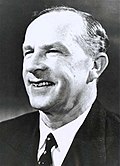List
There is a strong tradition of appointing new chief justices from within the existing ranks of the High Court. Out of the fourteen chief justices, eight were incumbent puisne justices on the High Court. Others have included incumbent chief justices of states (Samuel Griffith and Murray Gleeson) and incumbent attorneys-general (John Latham and Garfield Barwick). Uniquely, Robert French was appointed directly to the chief justiceship from a lower federal court, while Adrian Knox was appointed as a barrister in private practice with no judicial experience.
| No. | Image | Chief Justice | Tenure | Nominating Prime Minister | State | Previous Post |
|---|---|---|---|---|---|---|
| 1 |  | Sir Samuel Griffith (1845–1920) | 5 October 1903 – 17 October 1919 (16 years) | Alfred Deakin | Chief Justice of Queensland (1893–1903) | |
| 2 |  | Sir Adrian Knox (1863–1932) | 18 October 1919 – 31 March 1930 (10 years, 5 months) | Billy Hughes | Barrister in private practice | |
| 3 |  | Sir Isaac Isaacs (1855–1948) | 2 April 1930 – 21 January 1931 (9 months) | James Scullin | Justice of the High Court (1906–1930) | |
| 4 |  | Sir Frank Gavan Duffy (1852–1936) | 22 January 1931 – 1 October 1935 (4 years, 8 months) | James Scullin | Justice of the High Court (1913–1931) | |
| 5 |  | Sir John Latham (1877–1964) | 11 October 1935 – 7 April 1952 (16 years, 5 months) | Joseph Lyons | Attorney-General of Australia (1932–1934) | |
| 6 |  | Sir Owen Dixon (1886–1972) | 18 April 1952 – 13 April 1964 (11 years, 11 months) | Sir Robert Menzies | Justice of the High Court (1929–1952) | |
| 7 |  | Sir Garfield Barwick (1903–1997) | 27 April 1964 – 11 February 1981 (16 years, 9 months) | Sir Robert Menzies | Attorney-General of Australia (1958–1964) | |
| 8 |  | Sir Harry Gibbs (1917–2005) | 12 February 1981 – 5 February 1987 (5 years, 11 months) | Malcolm Fraser | Justice of the High Court (1970–1981) | |
| 9 |  | Sir Anthony Mason (born 1925) | 6 February 1987 – 20 April 1995 (8 years, 2 months) | Bob Hawke | Justice of the High Court (1972–1987) | |
| 10 | Sir Gerard Brennan (1928–2022) | 21 April 1995 – 21 May 1998 (3 years, 1 month) | Paul Keating | Justice of the High Court (1981–1995) | ||
| 11 |  | Murray Gleeson (born 1938) | 22 May 1998 – 29 August 2008 (10 years, 3 months) | John Howard | Chief Justice of New South Wales (1988–1998) | |
| 12 |  | Robert French (born 1947) | 1 September 2008 – 29 January 2017 (8 years, 4 months) | Kevin Rudd | Judge of the Federal Court of Australia (1986–2008) | |
| 13 |  | Susan Kiefel (born 1954) | 30 January 2017 – 5 November 2023 (6 years, 9 months) | Malcolm Turnbull | Justice of the High Court (2007–2017) | |
| 14 |  | Stephen Gageler (born 1958) | 6 November 2023 – present (2 years, 1 month) | Anthony Albanese | Justice of the High Court (2012–2023) |
Chief Justice Sir John Latham took a leave of absence from the office from 1940 to 1941 to serve as Australia's first ambassador to Japan. Sir George Rich was Acting Chief Justice in his absence. [8]